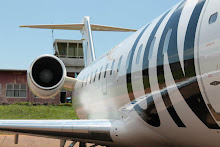The Regional Airline Shell Game
 Watch the jet. Can you find it yet? Wherever it lands, you're sure to fret.
Watch the jet. Can you find it yet? Wherever it lands, you're sure to fret.Do you wanna make a bet?
The first catalyst was the cost of fuel, which peaked last summer. The need to decrease capacity continues due to the dismal state of the economy.
Where the cuts come from and how deep is a constantly changing equation. At this point, I don't even think Delta knows. Since wholly owned subsidiaries don't have contractual capacity purchase agreements, it's easier to make changes with them. That is why they have put the screws to Comair.
Another way Delta is trying to reduce regional capacity is by canceling contracts of under-performing carriers. In May, Delta canceled their 50 seat contract with Freedom Airlines, a subsidiary of Mesa Air Group claiming poor completion and on-time performance. Mesa sued and received a temporary injunction to maintain the flying until the case goes to trial sometime in the first quarter of 2009.
In July, Delta announced that they were canceling Freedom's contract for 76 seat CRJ-900 flying as well. Those particular aircraft were owned by Delta and leased to Mesa/Freedom. Mesa had no recourse and Delta began the process of re-assigning the aircraft to other Delta Connection carriers.
First, they announced that the 15 aircraft (some of which have yet to be delivered by Bombardier) were going to Comair. By mid-August, Delta reversed that decision and temporarily assigned the aircraft to Pinnacle Airlines. This, along with the reduction in 50 seat aircraft, was the primary catalyst for my furlough, along with 205 and another 92 on January 16th, 2009.
In November, Delta announced that the remainder of the CRJ-900's were going to be placed with Mesaba, which has experienced tremendous growth in 2008. Now the reasons for that growth are another story entirely. To make a long story short, Mesaba was shrunk and squeezed a few years back and the pilot group is just now returning to it's original size.
Today, a memo was released by Mesaba. The memo stated that 10 of the 15 CRJ-900's that were assigned to them would now be given to ASA. ASA is the major Delta Connection carrier in Atlanta and is owned by Sky West. ASA has a great pilot group and they have been experiencing some reductions, including the loss of their ATR-72 turboprop fleet. Apparently, the awarding of the 900's was a 2 for 1 swap for 50 seat CRJ-200's. This ends up being a net loss of 10 aircraft. With and industry average of around 6 crews per aircraft, that means about 120 fewer pilots. So I wouldn't call it good news for ASA either.
Many of my fellow furloughed pilots had been recently hired by Mesaba and were due to start class on Monday, January 5th. I was glad to see them find work. Late this afternoon, they all received notice that their classes had been canceled. This just sucks.
2009 looks to be a very difficult year in the airline business. The hiring boom of 2007 was short lived. Too short lived. Rest assured there will be another, but with the increase in the mandatory retirement age to 65, it's going to be 2011 or 2012 before mass retirements become a factor and there is any substantial hiring at the majors.
I know there will be another "panic" hiring boom at the regionals before too long, but it won't necessarily be a healthy one. It will be due to the fact that there are so few people going through commercial flight training. The costs have skyrocketed and the lack of available credit for student loans will decrease the number of qualified entry level pilots. Best case scenario would be such a lack of newly trained pilots that the airlines are forced to offer competitive compensation for highly qualified pilots that have either walked away or gone overseas in search of better income. That is a subject of its own and would involve a virtual dissertation.
One thing is certain. Delta is going to continue to dangle larger regional aircraft like carrots in front of it's regional partners in order to drive costs lower. Regional airlines will fight for larger airframes and try to force their remaining pilots to fly bigger aircraft for less money. Scope will continue to be etched away. Until things change, (no I don't have the answer) the race to the bottom is going to be dirty, painful and destructive. The only thing I can do now is watch from the sidelines and hope for the best.
I will also continue to seek the answer to this question: If the CEO of DAL stated that there would be no loss of front line jobs as a result of the merger, why have over 300 pilots been furloughed from a wholly owned carrier?












